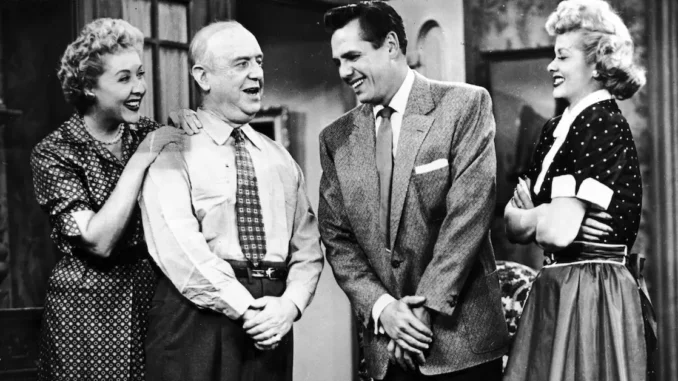
When I Love Lucy premiered on CBS nearly 70 years ago this month (on October 15, 1951), the show established Lucille Ball as a comedic legend. It also set a television template that lives on today.
Ball had starred in a successful CBS radio show called My Favorite Husband, starting in 1948. When the network wanted to turn it into a television series, the star had a few conditions. First, she insisted that her real-life husband, Desi Arnaz, play her husband on the show. Second, she insisted that the show be filmed in Los Angeles, where she and Arnaz lived with their baby daughter.
Previously, most TV series were shot in New York and broadcast live on the East Coast, with low-quality kinescope recordings — basically, films made by aiming a camera at a TV screen — sent to stations in the relatively unpopulated West. For I Love Lucy to be filmed in Los Angeles and broadcast nationwide, Arnaz turned to the new technology of a multi-camera shoot, with each camera filming on 35-millimeter film. That provided the necessary quality for national distribution. But Ball was also the kind of comic actor who needed an audience to respond to. So, Arnaz brought in a live studio audience.
I Love Lucy, as the Academy of Television Arts & Sciences puts it, was the first scripted show to be shot on 35-millimeter film in front of a studio audience. It’s how shows like The Big Bang Theory are shot even now. In other words, Ball and Arnaz invented the sitcom.
Over its six seasons, I Love Lucy — about bandleader Ricky Ricardo (Arnaz), his desperate-to-break-into-showbiz wife Lucy (Ball), and their neighbors and friends Fred and Ethel Mertz (William Frawley and Vivian Vance) — won five Emmy Awards. In four of its seasons, it was the top-rated show in the country. Even now, it’s regularly named among the best TV series of all time.
Beyond introducing the world to products like Vitameatavegamin (the health tonic Lucy overconsumes in “Lucy Does a TV Commercial”) and risks like the perils of a speedy assembly line (such as at a candy factory in “Job Switching”), I Love Lucy broke many other barriers and set many milestones.
When Ball demanded that Arnaz play her husband, CBS balked, arguing that viewers would never accept an all-American wife married to a Cuban-American man. So, she joined a nationwide tour of the Desi Arnaz Orchestra, adding vaudeville material that audiences loved. The network relented and Arnaz was cast.
When Ball became pregnant with their second child, it was the first time that a visibly pregnant star was permitted on a network TV series — except that CBS banned the apparently indelicate word “pregnant,” preferring “expecting.” And when that baby, Ricky Jr., was born, Ball and Arnaz scheduled the C-section to coincide with the broadcast of the I Love Lucy episode in which their TV baby was born. They knew better than to pass up the publicity: Ricky Jr. appeared on the cover of the very first TV Guide in 1953.
Perhaps most notably, though, when CBS balked at the additional cost of shooting on film in L.A., Ball and Arnaz agreed to reduce their salaries, but retain ownership of those films. Because of the films’ high quality, I Love Lucy created the rerun and syndication businesses. The production company they created, Desilu, became a powerhouse.
